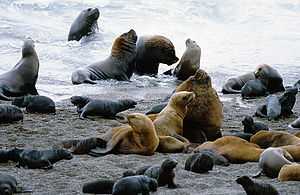Valdes Peninsula
The Valdes Peninsula (Spanish: Península Valdés) is a peninsula on the Atlantic coast in the Viedma Department in the north east of Chubut Province, Argentina. Around 3,625 km2 (896,000 acres; 1,400 sq mi) in size (not taking into account the isthmus of Carlos Ameghino which connects the peninsula to the mainland), it is an important nature reserve which was listed as a World Heritage Site by UNESCO in 1999.
Geography

Whale in Valdes Peninsula
The nearest large town is Puerto Madryn. The only town on the peninsula is the small settlement of Puerto Pirámides. There are also a number of estancias, where sheep are raised.
Most of the peninsula is barren land with some salt lakes. The largest of these lakes is at an elevation of about 40 m below sea level (see extremes on Earth), until recently thought to be the lowest elevation in Argentina and South America (the lowest point actually being Laguna del Carbón, Argentina).
Fauna
The coastline is inhabited by marine mammals, like sea lions, elephant seals and fur seals. Southern right whales can be found in Golfo Nuevo and Golfo San José, protected bodies of water located between the peninsula and the Patagonian mainland. These baleen whales come here between May and December, for mating and giving birth, because the water in the gulf is quieter and warmer than in the open sea. Orcas can be found off the coast, in the open sea off the peninsula. In this area, they are known to beach themselves on shore to capture sea lions and elephant seals.
The inner part of the peninsula is inhabited by rheas, guanacos and maras. A high diversity and range of birds live in the peninsula as well; at least 181 bird species, 66 of which migratory, live in the area, including the Antarctic pigeon.
References
- ↑ Selection criteria: "to contain the most important and significant natural habitats for in-situ conservation of biological diversity, including those containing threatened species of outstanding universal value from the point of view of science or conservation." "The Criteria for Selection". UNESCO World Heritage Centre. Retrieved February 2010.
- ↑ "Ramsar List". Ramsar.org. Retrieved 13 April 2013.
External links
Coordinates: 42°30′S 63°56′W / 42.500°S 63.933°W / -42.500; -63.933








